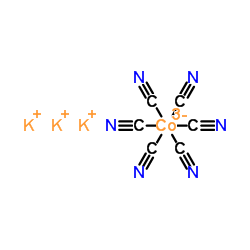Potassium hexacyanocobaltate

Potassium hexacyanocobaltate structure
|
Common Name | Potassium hexacyanocobaltate | ||
|---|---|---|---|---|
| CAS Number | 13963-58-1 | Molecular Weight | 332.332 | |
| Density | 1.878 g/mL at 25 °C(lit.) | Boiling Point | 25.7ºC at 760mmHg | |
| Molecular Formula | C6CoK3N6 | Melting Point | N/A | |
| MSDS | Chinese USA | Flash Point | N/A | |
| Symbol |

GHS07 |
Signal Word | Warning | |
|
An NMR study of anion binding to yeast phosphoglycerate kinase.
Eur. J. Biochem. 190(1) , 161-9, (1990) Anion binding to yeast phosphoglycerate kinase has been investigated using 1H-NMR spectroscopy. The use of anionic paramagnetic probes. [Cr(CN)6]3- and [Fe(CN)6]3-, has enabled the location of the primary anion binding site in the 'basic-patch' region of the ... |
|
|
The modulation of cytochrome c electron self-exchange by site-specific chemical modification and anion binding.
FEBS Lett. 206(1) , 15-9, (1986) The site-specific chemical modification of horse heart cytochrome c at Lys-13 and -72 using 4-chloro-3,5-dinitrobenzoic acid (CDNB) increases the electron self-exchange rate of the protein. In the presence of 0.24 M cacodylate (pH* 7.0) the electron self-exch... |
|
|
Toxicity of cobalt-complexed cyanide to Oncorhynchus mykiss, Daphnia magna, and Ceriodaphnia dubia. Potentiation by ultraviolet radiation and attenuation by dissolved organic carbon and adaptive UV tolerance.
Environ. Sci. Pollut. Res. Int. 14(5) , 333-7, (2007) Cobalt cyanide complexes often result when ore is treated with cyanide solutions to extract gold and other metals. These have recently been discovered in low but significant concentrations in effluents from gold leach operations. This study was conducted to d... |
|
|
Association constants for metal hexacyanide binding to cytochrome c.
J. Inorg. Biochem. 21(3) , 253-61, (1984) The binding of [Co(CN)6]3-, and that of [Fe(CN)6]3- and [Ru(CN)6]4- using a competitive method, to horse cytochrome c has been studied by 59Co NMR spectroscopy. At I = 0.07 M, without added salt and in 2H2O at pH* 7.3 (measured in 2H2O) and 25 degrees C, ther... |
|
|
Interaction of ribonucleotides with metal hexacyanocobaltate(III): a possible role in chemical evolution.
Orig. Life Evol. Biosph. 37(3) , 225-34, (2007) It has been proposed that metal cyanide complexes would have acted as effective prebiotic catalysts. Insoluble metal cyanide complexes could have concentrated biomonomers from the dilute prebiotic soup, facilitating certain prebiotic reactions. In the light o... |
|
|
A 59Co NMR relaxation probe of macromolecule anionic binding sites.
Anal. Biochem. 106(2) , 373-6, (1980)
|
|
|
Reynhardt EC and Boeyens JCA.
Acta Crystallogr. B Struct. Sci. Cryst. Eng. Mater. 28(2) , 524-529, (1972)
|
|
|
The reduction of iodopentamminecobalt (III) iodide and potassium hexacyanocobaltate (III) with potassium in liquid ammonia. Watt GW and Thompson RJ.
J. Inorg. Nucl. Chem. 9(3) , 311-314, (1959)
|
|
|
Effect of pH on Retention of 134Cs and 60Co from MAW by Potassium Hexacyanocobaltate(III). Mekhail FM, et al.
Isotopes Environ. Health Stud. , 130-33, (1991)
|